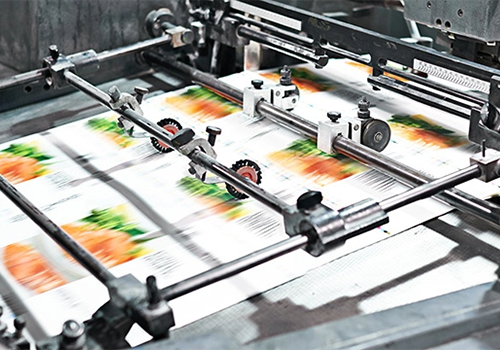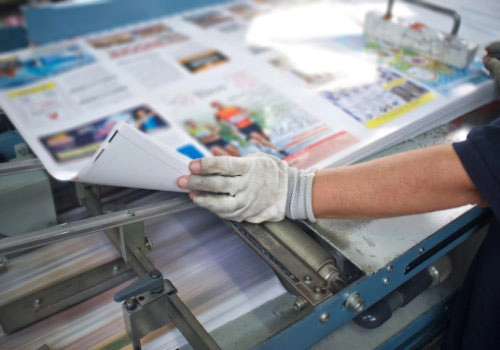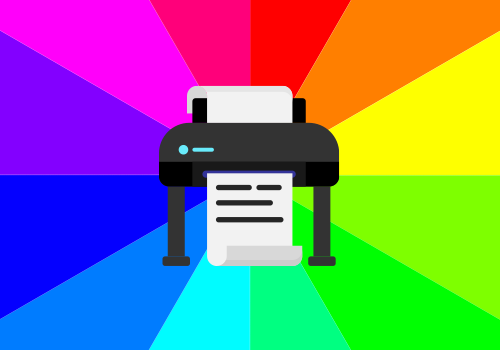Commercial Printing: Processes, Applications, and Importance
Step into the world of commercial printing, where precision, innovation, and technology come together to produce visually striking materials.

At its core, commercial printing is all about putting ink onto paper. However, this seemingly straightforward process is anything but simple.
There are two main methods: traditional and digital printing.
- Traditional Printing: This category encompasses well-established techniques such as offset and letterpress printing. It reflects the heritage of the industry, with each printed page receiving individualised attention.
- Digital Printing: In contrast, digital printing leverages cutting-edge technology to deliver precise, high-speed results. It is the embodiment of efficiency and consistency, making it the preferred choice for many contemporary printing needs.
Commercial printing finds versatile applications in marketing, publishing, and packaging industries, transforming ideas into tangible materials that engage, inform, and persuade. From eye-catching brochures and captivating magazines to durable packaging that protects and enhances products, commercial printing brings life to visual communication strategies. It's a vital tool for businesses of all sizes, enabling them to connect with customers, promote their brands, and drive sales.
Printing Processes
Commercial printing encompasses a spectrum of techniques, each with its own merits and applications.
Offset Printing: Offset printing, often referred to as lithography, remains a prevalent choice for high-quality, high-volume projects. It involves the transfer of an image from a plate to a rubber blanket, which is then pressed onto the printing surface. Offset printing is known for its exceptional colour accuracy, making it an ideal choice for brochures, catalogues, and magazines.
Digital Printing: Digital printing, on the other hand, offers unparalleled flexibility and speed. It uses digital files to directly reproduce images and text onto various substrates, making it suitable for short runs and quick turnarounds.

Flexography: Flexography, or flexo printing, is a versatile process often used in packaging and labelling. It utilises flexible relief plates and fast-drying inks, making it a preferred choice for food packaging, labels, and corrugated containers. Flexography excels at printing on various materials, including plastic, paper, and foil.
Gravure Printing: Gravure printing is synonymous with high-volume production and fine detail. It involves etching an image onto a cylinder, which is then used to apply ink to the paper. Gravure is known for its impeccable image quality and is commonly found in the production of magazines, catalogues, and decorative materials.
Screen Printing: Screen printing is valued for its versatility, making it suitable for a wide range of substrates, from apparel to signage. In this process, ink is pushed through a stencil onto the printing surface. Screen printing stands out for its durability and vibrant colours, making it ideal for items like T-shirts, posters, and promotional products.
Each of these printing processes has its unique strengths, making them suitable for various applications. Understanding the distinctions between them is crucial for businesses looking to make the right choice for their projects.
Diverse Applications
Commercial printing's reach extends across a diverse spectrum of applications, playing a pivotal role in numerous industries.
Advertising: One of the most prominent applications of commercial printing is in the realm of advertising. Whether it's eye-catching posters, brochures, or banners, printed materials are a tangible and effective way to capture an audience's attention. High-quality print can enhance the visual appeal of advertisements, making them more compelling and memorable.
Packaging: Commercial printing plays a vital role in product packaging, offering not only aesthetic appeal but also functional benefits. Labels, cartons, and packaging materials are all opportunities for businesses to communicate their brand identity and product information. High-quality printing ensures that the packaging accurately reflects the product's quality and purpose.

Publishing: From books and magazines to newspapers, the publishing industry relies heavily on commercial printing. Print media remains a trusted source of information and entertainment for countless readers. Publishers understand that the quality of the printed material impacts reader engagement and perception, making high-quality printing an absolute necessity.
Promotional Materials: Promotional products like branded merchandise, brochures, and flyers are essential tools for marketing and promotion. Commercial printing enables businesses to create visually appealing and informative materials that leave a lasting impression on customers and prospects.
Interior Design and Decor: Commercial printing extends beyond traditional advertising and marketing. It plays a significant role in interior design and decor. Wallpapers, wall murals, and custom artwork are all created through digital printing, adding a personalised touch to homes, offices, and retail spaces.
Event Signage: For events, conferences, and trade shows, event signage is crucial for guiding attendees and creating a professional atmosphere. Banners, posters, and backdrops are printed using large-format printing techniques, ensuring a polished and cohesive visual experience.
Photography and Art Reproduction: Commercial printing is indispensable for artists and photographers looking to reproduce their work accurately. Fine art printing and photo printing processes allow for faithful colour reproduction, making prints indistinguishable from the original artwork.
In today's competitive landscape, the impact of high-quality commercial printing on marketing and branding cannot be overstated. It's not merely about conveying information; it's about making a lasting impression. The tactile and visual appeal of printed materials fosters a deeper connection with audiences and elevates brand recognition.
The Crucial Role of RIP Software
Within the commercial printing industry, where precision and consistency are non-negotiable, RIP (Raster Image Processing) software takes centre stage. It assumes a pivotal role in colour management, print quality enhancement, and workflow efficiency optimisation.
This software acts as a vital bridge, seamlessly translating intricate digital data into a format that printers can faithfully reproduce. It interprets digital instructions and ensures the precise realisation of digital designs.
Solutions like Serendipity's Blackmagic and Megarip are recognised for their expertise in advancing colour management, improving print quality, and optimising workflow efficiency.
Key Attributes of RIP Software:
- Accurate Colour Reproduction: RIP software plays a vital role in ensuring precise colour matching for brand consistency and maintaining photo integrity in commercial printing.
- Precision in Printing Parameters: Fine-tunes resolution and dot gain, ensuring optimal print quality.
- Efficiency and Automation: RIP software streamlines printing processes, automating tasks, reducing errors, and optimising ink and media usage, contributing to cost-effective and timely operations.
- Versatility Across Applications: From fine art printing to packaging and large-format posters, RIP software guarantees high-quality output across diverse printing applications.
- Brand Consistency: For businesses prioritising branding, RIP software ensures faithful reproduction of intended colours in logos, packaging, and marketing materials, reinforcing brand identity.
- Adaptability to Workflows: Compatible with various printing workflows, RIP software suits both small print shops and large-scale commercial operations, offering customisable tools for job-specific needs.
RIP software silently ensures the precise and consistent realisation of digital designs from creative minds and businesses into tangible, top-tier prints. It serves as the cornerstone, upholding brand fidelity, customer contentment, and the smooth operation of the printing workflow.
Importance of Quality Control
Quality control is the linchpin of commercial printing, ensuring that the results meet the highest standards and guaranteeing brand integrity and customer satisfaction.
- Consistent Colour: Colour consistency is vital for brand recognition and customer trust. Any variations in colour can lead to a lack of confidence in your brand. Quality control measures, including proper colour calibration and regular checks, help maintain colour fidelity across print runs, ensuring that your brand colours are accurately represented.
- Print Quality: Print quality goes hand in hand with colour consistency. Quality control checks ensure that text and images are sharp, and details are reproduced faithfully. Any inconsistencies or defects are identified and rectified, preserving the overall quality of the print job.
- Precision in Finishing: The final presentation of printed materials is equally critical. Quality control extends to the finishing process, which includes cutting, folding, binding, and other post-printing tasks. These processes need to be executed accurately to ensure the final product looks polished and professional.
- Calibration and Maintenance: Regular maintenance and calibration of printing equipment are fundamental aspects of quality control. Machines must operate at their peak efficiency to consistently deliver high-quality results. Scheduled maintenance reduces the risk of downtime and ensures that the equipment operates optimally.
- Client Satisfaction: Satisfied customers are repeat customers. Ensuring that your prints consistently meet or exceed their expectations is essential for client satisfaction. Quality control measures are key to achieving this goal, as they minimise errors and inconsistencies that can lead to customer complaints.
- Cost-Efficiency: Quality control isn't just about maintaining high standards; it's also about preventing costly errors. Mistakes in printing can result in wasted materials and reprints. A robust quality control process can save your business time and money by catching issues before they become expensive problems.
Quality control in commercial printing is the backbone of delivering consistent, top-tier results. It upholds brand integrity, fosters customer satisfaction, and supports cost-efficient operations. By implementing quality control measures, businesses can ensure that their printing projects meet the highest standards, leaving a lasting positive impression on their audience.
Print's Lasting Impact
In the dynamic realm of commercial printing, where technology, creativity, and precision converge, visually captivating and impactful materials come to life. From eye-catching brochures to durable packaging, commercial printing transforms ideas into tangible pieces that engage, inform, and persuade.
With a variety of printing methods and the power of RIP software, commercial printing continually adapts to the changing world of technology and design. Despite the prevalence of digital content, print still holds its unique place. It engages the senses, stirs emotions, and leaves a lasting impression. For businesses, this is where the power of commercial printing truly shines, offering a timeless impact in a digital age.



